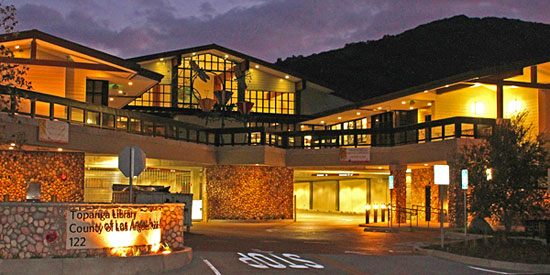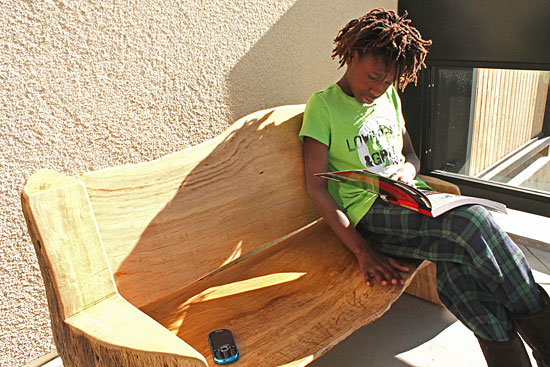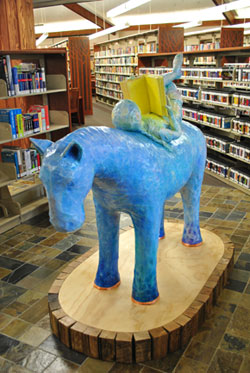New library tells Topanga’s story, too
January 17, 2012

The new Topanga Library reflects the spirit and sensibilities of the artistic Santa Monica Mountains community.
It may not be easy to tell a book by its cover, but when the county’s newest library opens this weekend, visitors will have no trouble knowing which community’s stories are surrounding them.
From the design to the public artwork, the long-awaited Topanga Public Library, which will be dedicated on Saturday, is an organic outgrowth of the community it will soon serve.
“They tried to make it as homegrown as possible,” says Topanga artist Matt Doolin, who, with his brother Paul and his mother Leslie, created a circular tile mural of an idyllic Topanga landscape that will anchor the library’s main room.
The 11,293-square-foot, silver LEED-certified building broke ground in 2008 and has been in the works for more than a decade; for generations, residents of the mountain community had made do with other towns’ libraries and a visiting bookmobile. (Click here for a gallery of early construction work.)
Although Los Angeles County funded the $19.6 million project, it was clear from the start that the iconoclastic community, filled with environmentalists and artists, would insist on weighing in on the building’s aesthetic and carbon footprint.
“There are a lot of stakeholders in Topanga,” laughs Rebecca Catterall, former president of the Topanga Canyon Gallery and a 30-year-resident of the rustic enclave.
“There’s a sense of a spiritual connection there that’s not like any other place, and I think it’s important to the people,” agrees Norman Grochowski, who spent most of his career in Topanga and whose massive-yet-whimsical steel-and-ceramic book flowers bedeck the library’s entry.
“Topanga is a land within a land, a place far away.”
So a local design advisory committee was convened to determine the rustic “lodge” look of the North Topanga Boulevard building, and the library was built to the latest green construction standards.
Meanwhile, in accordance with county policy, one percent of the cost of construction was allocated for the incorporation of civic art into the project. A second local committee, this one pulled from the local art scene by the Los Angeles County Arts Commission, commissioned pieces by four local artists. (Click here for an extensive photo gallery of the of the library’s artwork on Green Public Art’s Flickr page.)
Catterall, who sat on the arts committee, says the group methodically culled 29 entries in search of artists who were both representative of the community and who worked on an architectural scale. Patricia Correia, a Topanga-based art dealer and former gallery owner who served with Catterall, says the artists were chosen first and then asked to make pieces for specific areas of the building.
“A lot of times in public art, people pick a beautiful sculpture and then find out it’s too small or too big.”
Some aspects of the new library ended up being literally rooted in Topanga: A podium, two Adirondackchairs, two rocking chairs and a picnic table were made from trees that had had to be removed during construction. That work, set in motion by Supervisor Zev Yaroslavsky’s office, was done by Don Seawater, whose California-based Pacific Coast Lumber Co. is a leader in the use of reclaimed wood and urban forestry.
Artist and art teacher Megan Rice, who did two papier mache sculptures for the library’s children’s section, also honored the fallen trees—two oaks and two pines—by using one of the stumps as the base for “A Great Tale,” which depicts a little boy reading to his faithful dog.
“I’ve lived in Topanga since 1956, and when I heard they were looking for artists with a vested interest in Topanga, I felt, ‘That’s me’,” says Rice, who was 5 when her parents moved to the community.
“My mother was the children’s librarian at Topanga Elementary School for eight or ten years, and I grew up with the bookmobile—in fact, in my early childhood, it was a very big part of my life because we had few neighbors, and for a long time my mother didn’t have a car, so getting a big stack of books there was a source of great excitement for me.”
Local potter Jim Sullivan, a resident since the early 1960s, remembered the Topanga childhood of his now-grown daughter when he designed the ceramic tile “rug” just inside the front entrance. “When she was in fourth grade, she went to the Adamson House inMalibu, and the docent stopped them at the front door and pointed to the threshold,” says Sullivan. “She said, ‘Does anybody know what that is?’”
Only Sullivan’s daughter, the child of a ceramist, knew that the design on the floor was a broken tile mosaic. When the guide explained that broken tile was often used in doorways because of ancient lore that it kept out evil spirits, Sullivan says his daughter became so excited that she begged him relentlessly to install similar mosaics in their own house.
Since then, he says, he has done a number of such installations, and when he heard about the library commissions, he felt a piece of broken-tile floor art would be perfect for Topanga’s new landmark. His 8-foot-wide piece, made entirely by hand, he says, depicts a spark growing into a flame of intellect and community.
All the artists who contributed work are established and well known in Topanga. The Doolins have done murals at local landmarks ranging from Disneyland California Adventure to public pools in South Los Angeles. Grochowski, who now lives in Crescent City, Ca., but visits Topanga several times a year, has shown work at LACMA and the Laguna Art Museum.
Rice’s work has been exhibited throughout California, and Sullivan, whose ceramics are in a number of private collections, has done historic restoration work from Malibu to Pasadena; for many years he co-owned Malibu Ceramic Works, a Topanga tile company that replicated historic tiles.
Correia says the work by Sullivan and the Doolins echoes Topanga’s long history as a center for ceramic artwork and the sculptures by Rice and Grochowski brought variety.
“There aren’t a lot of libraries getting built anymore,” she notes. “It was exciting, and we wanted to bring a three-dimensionality to the space, take it beyond just a big painting or a big mural outside.”
The new library “is incredibly important,” adds Correia.
“We don’t really have an everyday kind of communal place that isn’t a commercial space,” she says. “This is going to bring the community together in a way that deals with knowledge and culture and imagination. I can’t wait.”
The library’s grand opening will take place Saturday, January 21, at 11 a.m. The address is 122 N. Topanga Canyon Blvd.

Some of the library's furniture, such as this bench, was crafted from trees that were cleared for the facility.
Posted 1/17/12
















 405 bridge work causes a stink
405 bridge work causes a stink